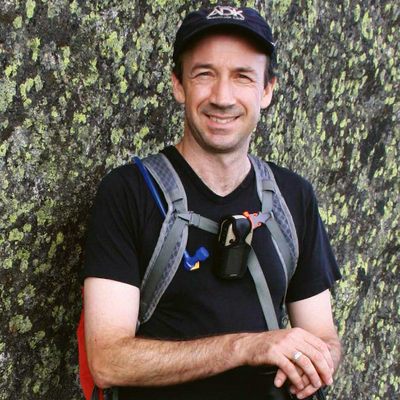
U.S. Geological Survey, Patuxent Wildlife Research Center
What did you study?
In the webinar, I talk about a study we did of brown trout in the Colorado River downstream of Glen Canyon Dam. These non-native fish, which pose a threat to the native humpback chub, have increased in recent years for unknown reasons. We were interested in evaluating possible management interventions, and whether the choice of the best intervention was impeded by uncertainty.
If you were a plant, what species would you be and why?
Huperzia lucidula (shining clubmoss), a small plant that covers the forest floor in the Green Mountains of Vermont and the Adirondacks of New York, where I grew up. Or, maybe I’d be Eucalyptus pauciflora (snow gum), the graceful pale trees in the open meadows of the high alpine plains in Victoria, Australia.
Why do you work on environmental problems?
On a technical level, environmental problems are challenging and fascinating. The ecological systems are more complex than we can imagine, and the decisions about how to manage them require us to work at the interface of science and policy.
On a spiritual level, we’ve got one planet. The life on it is profoundly diverse and deeply interconnected, and I believe we have responsibility to care for it.
How did you come to contemplate decision analysis and why?
I started graduate school with a simple question in mind, “How do we make environmental science relevant to decision makers?” As naïve as I was about what that meant, that question led me to study decision analysis and that education has shaped the way I think about everything.
What did your career pathway to where you are now look like?
As an undergraduate, I studied molecular biology and philosophy, with a pretty firm grounding in chemistry and math as well. I had worked in a lab studying protein biochemistry, thinking I’d want to go to grad school in that field, but found the lab work a little isolating. So, after undergrad, I taught high school math and science for five years, before returning to grad school to study wildlife science and decision analysis. After grad school, I took a post-doc at the Patuxent Wildlife Research Center to develop new applications of adaptive management. That eventually turned into a permanent position and I’ve been there since.
What is the hardest career decision you have made, would you change it if you could?
I work in the applied arena, with real decision makers on real problems. Each project takes time-time that could be spent writing papers or grants, or engaging in other activities that accelerate professional advancement. So, I’m constantly having to think about how I allocate my time, and whether I’m making the right trade-offs. But no, I wouldn’t change my choice to focus on applied work. Real problems are hard, and it means something to me to help ecological managers improve their decision-making processes.
What is your best piece of advice for an early career researcher in the environmental sphere?
Teach. Somehow, somewhere, in some capacity. You’ll learn your subject better than you ever knew it before. You’ll improve your communication skills immensely. And you’ll learn a little humility, which maybe isn’t a bad thing.
If you had one wish, what environmental issue would you solve and why?
Is this a trick question? Climate change, of course. But how? One of the intriguing aspects to me is how we get people, individually and collectively, to think about balancing short-term and long-term consequences in a way that makes sense for them, their children, and their grandchildren. People frame the question so differently that we’ve ceased to have meaningful discussions about shared values. How do we overcome that?